Ahead of the Academy Awards, we’ve reviewed every short film in each category: Animation, Documentary, and Live Action.
Animation
Burrow | USA | 6 MINS
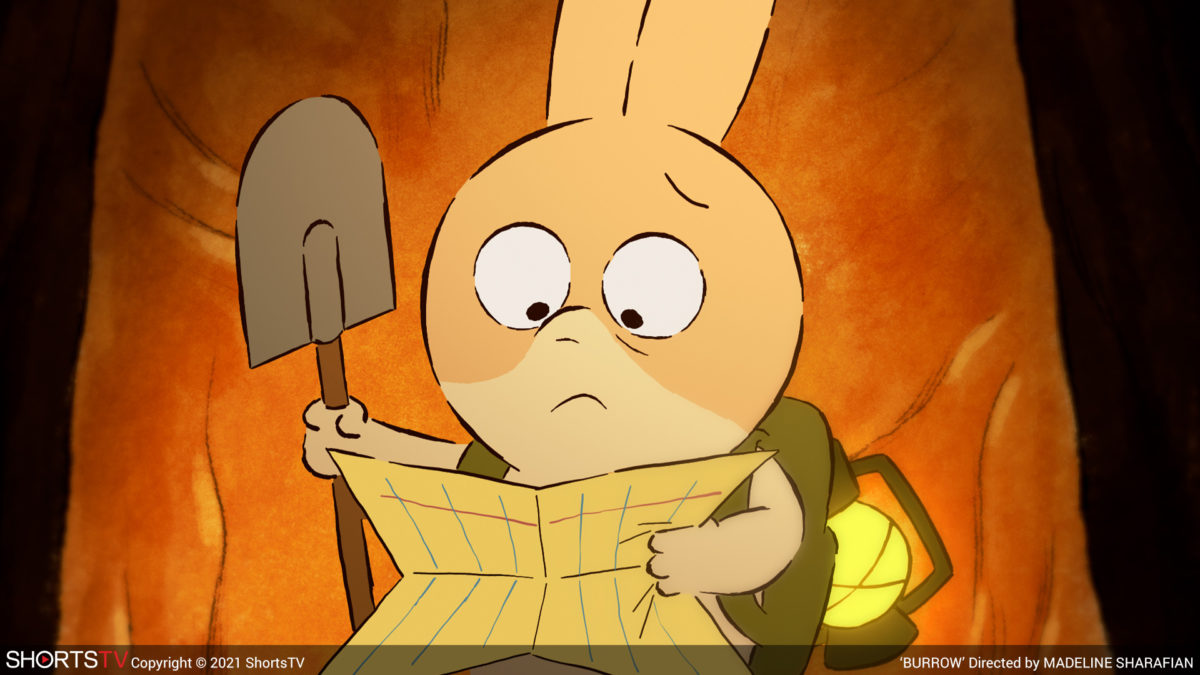
I said it two years ago with Kitbull and will say it again now: it’s weird to watch a Pixar production utilizing a two-dimensional, hand-drawn style after so many years of computer animation. Madeline Sharafian’s Burrow continues that trend within the Disney+ Sparkshorts series and her tale of a young rabbit looking to dig out her dream home in the dirt. There’s a Little Golden Books appeal that hit me with a ton of nostalgia as her unwavering joy is shattered by not one, but two neighbors popping their heads through the walls separating her from their more ambitious abodes. One look at what they’ve each created sends her enthusiasm levels down to zero—her blueprints of a single room habitat a pale comparison conjuring only embarrassment instead.
So what does she do? Dig deeper to get away, hide, and allow her humble fantasies to be enough. With every new tunnel, however, comes another new animal neighbor settled into a veritable mansion. The most unfortunate part of her unnecessary shame is the fact that it refuses to let her see that each new accidental intrusion brings with it a potential new friend cheering excitedly for her to succeed. The moles, frogs, and even the ants all wish the best for her and even break out the pens to help expand her initial vision if only she acquires the confidence to let them see the paper she’s been guarding since her first uninvited guest arrived. Rather than open her eyes, she closes them tighter in wholesale retreat.
There’s a lot to be said about her feelings of shame both for ruining these strangers’ homes and no longer thinking hers is good enough. So many of us have that knee-jerk reaction wherein we don’t believe we’re worth the trouble we think we’ve caused simply by existing. And we run and hide for so long that it becomes our fate to find ourselves lost and alone within a situation that demands assistance before it ruins the lives of everyone we’ve been desperate to avoid. One such incident occurs here to force this rabbit into knocking on the scariest door of them all with ears tucked to beg for help. And what does she find? A community all too ready to drop everything they’re doing to rescue her.
That’s the ideal, right? To reside in a place where you can lean on your neighbor and they can lean on you back. In an era of impenetrable walls and closed doorways, a reminder that trust isn’t something we have to put a monetary value on is as much a breath of fresh air as the vintage animation used to supply it. Sharafian’s parable exudes warmth and love in every frame even if its lead can’t quite escape her own head long enough to realize it until the end. As long as we still recognize its brightness and inspiration, we know that she’ll eventually do the same too since we all make mistakes that we need help from strangers to fix. Most times we simply have to ask.
B
Genius Loci | France | 16 MINS
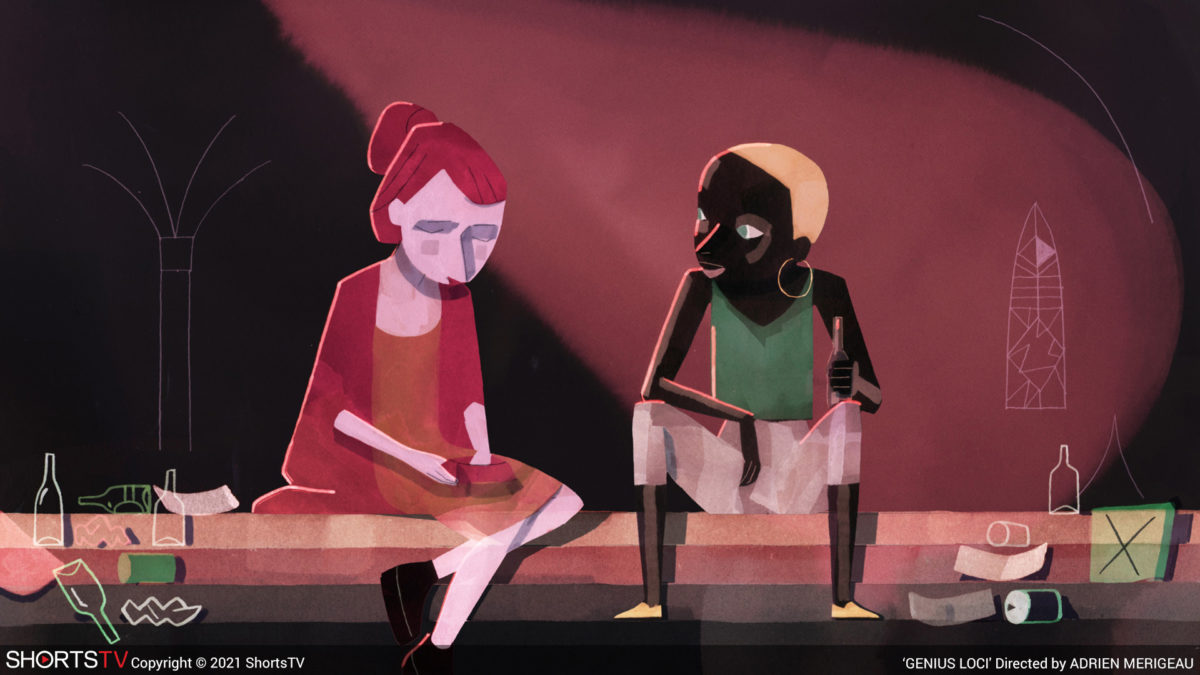
With its esoteric dialogue and often cacophonic score incorporating foley sound effects with the melody that also double as the driving rhythm upon which the visuals are cut together, Adrien Merigeau’s Genius Loci (co-written by Nicolas Pleskof) eschews traditional narrative for a beat poet aesthetic that embraces disorder on a journey through time and space. Reine (Nadia Moussa) is at once present in her sister’s apartment (watching a pot boil over upon the stove while simultaneously watching a baby in a crib) and elsewhere either in her past, future, or imagination to find friends, music, and abstract visions of kaleidoscopic animation breaking apart and reforming with little meaning to discern beyond the emotional impact of its colorful motion and anxiety-inducing scenes of physical and psychological transformation.
Things move from the thick brushstrokes of watercolor to the rough crayon-filled fields of geometric shapes—Cézanne to De Kooning, impressionism to abstract expressionism—all while continuing to circle back to a reality forever threatening to dismantle itself down to symmetrical shapes of black and white precision. Reine is at once herself, her essence, and a dog running through the streets after standing still for too long to embrace the chill vibe of an impromptu concert amongst friends. Her loner attempts to isolate herself from the noise of the world, an introvert trapped in a mind that can’t be bothered with explanations or etiquette when the noise becomes too much to bear. So she escapes into dream and/or nightmare, the city’s sounds and sights guiding her back home.
You either let yourself absorb its atmospheric mood or construct your own barriers to hold its eccentricities and amorphous consciousness at bay—there’s no middle ground. Those who need plot will be let down, but hopefully they’ll embrace its ability to almost exist on a level above design to both erase the need and repurpose the loosely drawn backstory of a woman lost in a world of her own as a framework anyway. There’s a lot to relate to then for those who find themselves perpetually on the outside looking in. The wallflowers. The observers. The sensory sensitive who cannot stay in one place for too long before taking their leave on a whim and without notice. Some rein in chaos. Others dance amidst its discord.
B
If Anything Happens I Love You | USA | 12 MINS
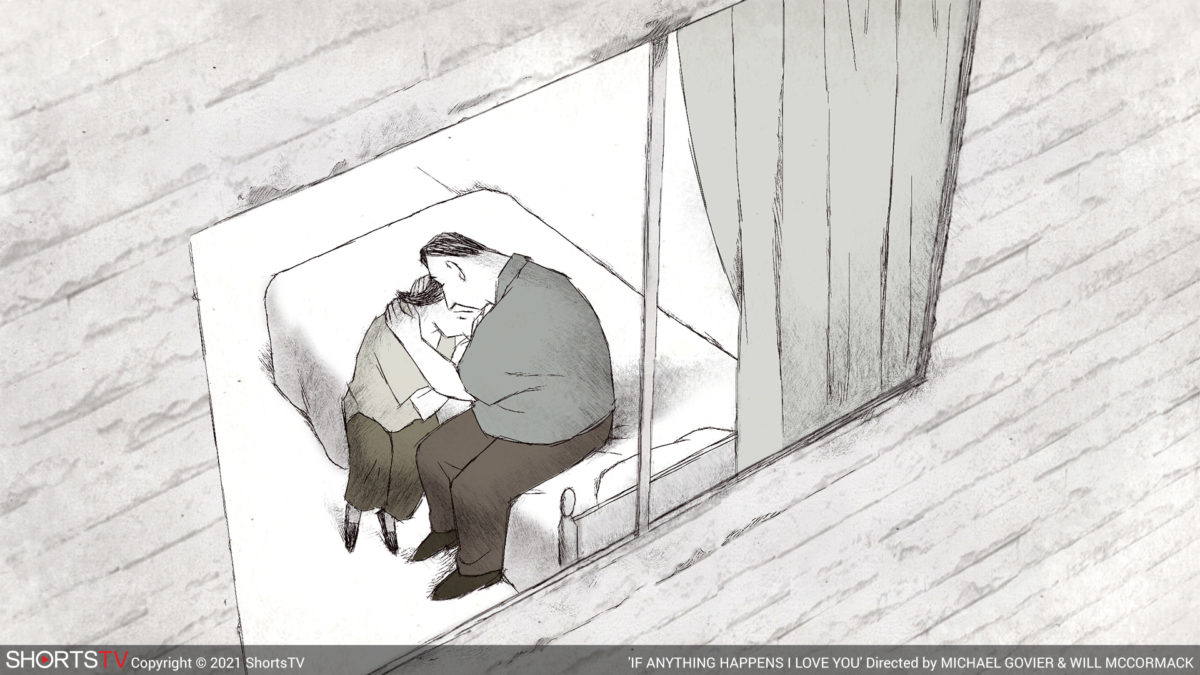
It’s never easy to overcome immense tragedy—especially when it involves a child. We feel the obvious absence at the start of Michael Govier and Will McCormack’s If Anything Happens I Love You through its leads’ inability to look each other in the eyes and the anger their shadowy counterparts (embodiments of their emotions) exude behind them. We receive glimpses of joy met with isolation as every attempt to remember what was fades in the second it takes to realize there’s no going back. A paint splotch on the garage and a barren flowerbed each recalls happier times just as they inevitably reinforce this current sorrow until a serendipitous sign of life forces them to acknowledge they still have each other to lean on and prevail.
The sentiments intrinsic to this truth are powerfully relatable even for those who’ve been lucky enough to avoid the experience of losing a loved one too young. Focusing on the parents in the aftermath supplies us an avenue towards learning that loss doesn’t have to guarantee separation. Treating remnants of the past as ghosts haunting us isn’t an unavoidable fate if we can find the strength to embrace those objects as spirits of love. So while a t-shirt can’t help but conjure melancholy insofar as who isn’t wearing it, what it depicts and where it’s from also possesses the potential to travel backwards and relive the wonder of both its origins and those of its former owner. That’s how we keep the dead alive inside us.
While Govier and McCormick’s film does follow that path to its logical and heartfelt conclusion, however, it also introduces a jarring bit of context that almost seems unnecessary despite its relevance. I get the desire to hold the cause of this child’s death back for greater impact, but it’s one thing to supply it naturally with nuance and another to blindside us in a bid to willfully create controversy. I don’t want to presume intent, but I can’t quite shake the feeling that the latter is exactly what the filmmakers had in mind. And while that is their prerogative, I do hope they understand how alienating that decision can be for the audience. Things go from sympathetic mourning to “sign this petition” energy in an instant.
It’s therefore tough to give them the benefit of the doubt and believe that it’s just one detail of many for why this couple is hurting so badly. This child could have died one hundred different ways and the emotions would be the same. So making this choice without also making the film about that same choice is inherently manipulative. It uses it to cause a reaction rather than to enhance the story—and that’s coming from someone who’s just as angry about its devastating truth as the directors are. I just don’t like being lulled in with a memorably soft aesthetic (charcoal-filled line drawings with a sketchy feel) and the potential cloud-lift of depression only to get slammed into a wall of impotent rage out of nowhere.
C
Opera | USA/South Korea | 9 MINS
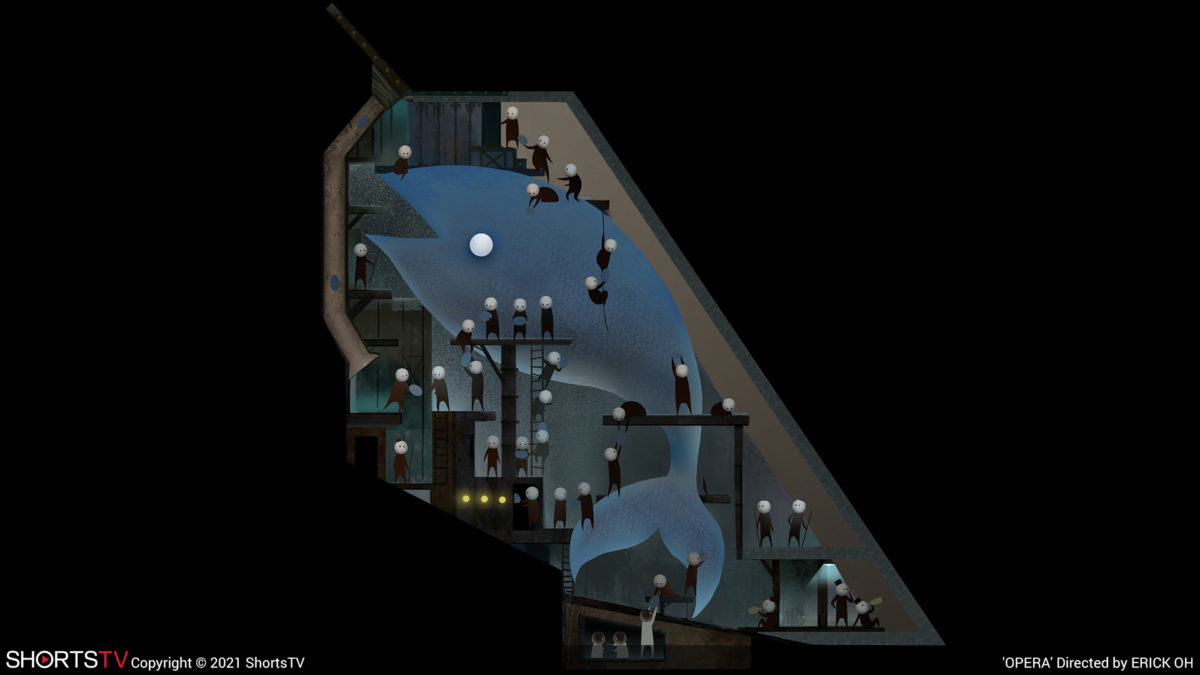
With a triangular structure composed of about one hundred different individual compartments that all connect via a religiously, bureaucratically, and militarily closed-loop ecosystem, it is impossible to fully comprehend everything that’s going on in one go. Erick Oh’s Opera therefore becomes more a treatise on society’s ills, aspirations, failings, and successes than a narrative with A to B propulsion as a result, its infinite cycle of night and day (as dictated by an hourglass turn) becoming a nightmarish depiction of the nine circles of Hell as much as the faith-based dreams of divinity. White-headed figures eat, work, and worship while dark-headed figures await their moment for revolution in a chaotic scene of fire and brimstone all but extinguished once the switch is flipped to do it all again.
The closest thing I can compare the piece to aesthetically is the mobile videogame Monument Valley and its intricately designed optical illusions of bridges and tunnels populated by figures caught on its tracks to progress forward. Imagine those games zoomed out so that we see the entirety of their geography at once, the camera panning over its breadth of information without context or purpose beyond the assurance that its machinations are laid bare for us to digest and interpret on our own. Do we watch the zealotry? Or the bodies alternating from coffins in the ground to meat grinding conveyor belts recycling eaters into eaten? Do we watch as one side sends everything upwards to its rulers? Or the other as its rebels move down for inevitable bloodshed?
Its detail is exquisite, its content mesmerizing. As the description talks about our history and society holding beauty and absurdity, we recognize the ways in which those notions augment and oppose each other on-screen through these parallel vignettes. That the keyhole exists at the top and the key at the bottom only reveals how an end is impossible. Good reaps bad. Bad births good. One side is the hero and the other the villain—each flip-flopping depending on your own selfish desires and/or unavoidable desperation. A prison is survival and death. A library is education and censorship. Our duality of existence is given abstract form in a uniquely idiosyncratic world that stands alone and as metaphor. Everyone is a slave to its progress and creator of its destruction.
A
Yes-People | Iceland | 8 MINS
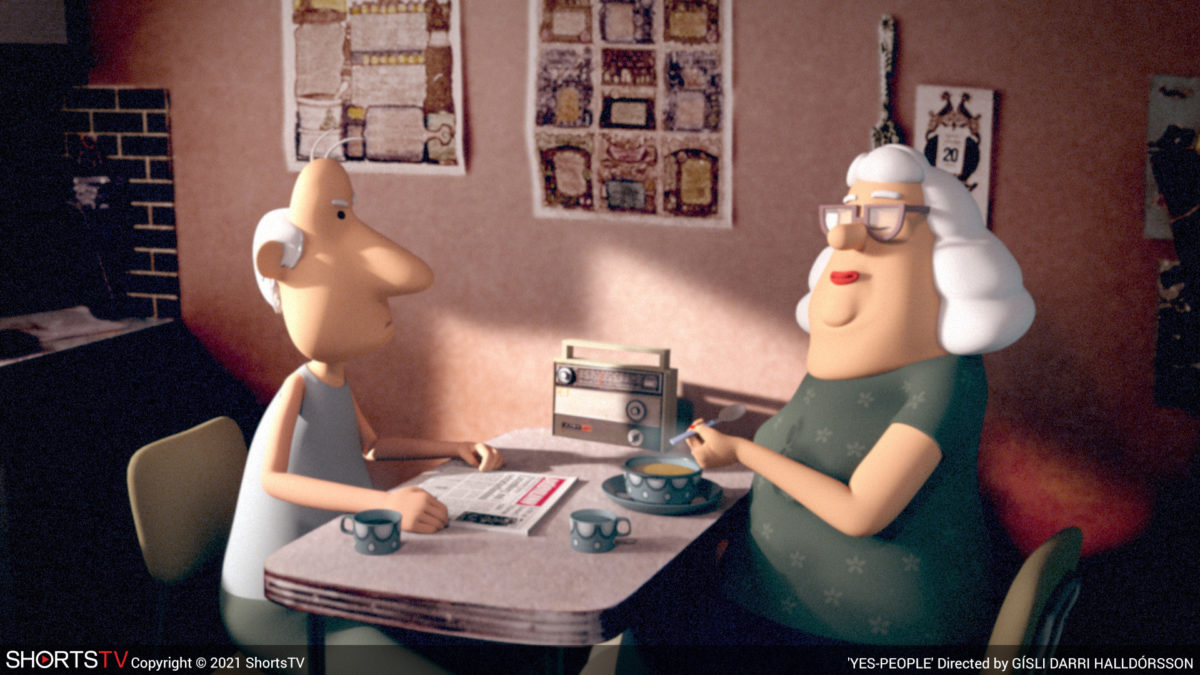
Life beats us all down eventually. Or, if we’re lucky, it numbs us from caring about the chaos that surrounds us. This is only too true for the inhabitants of three apartments within Gísli Darri Halldórsson’s short film Já-Fólkið [Yes-People]. Whether it’s the senior couple at a breakfast table daring each other to blink during an impromptu “who’s most annoying” contest or a cheery mother and her morose son getting through teaching clarinet to a novice and staying awake at school respectively or a frustrated middle-aged pair who’ve turned to vices (food and alcohol) in a bid to ignore each other, these people provide us a funny, absurd, and all-too relatable look into the odd ways in which we cope with the monotony of suburban life.
The result is a cutely rendered lark that will have you wincing at the familiarity as much as crying with laughter. There are the small victories like shoveling the sidewalk or getting a student to improve just slightly enough that you don’t want to rip your hair out or accidentally scream at them for something that isn’t their fault. There’s finding a hidden cookie in your desk drawer to satiate a grumbling stomach or ignoring self-control to dig out that flight-size bottle of booze under the sink to escape the dreariness of another afternoon that proves how meaningless calendars are when you have nothing to differentiate today from tomorrow. And who hasn’t lived somewhere with thin enough walls to find dinner serenaded by screams of ecstasy next door?
Its appeal is therefore Halldórsson’s ability to find humor in the mundane. By using expressions, grunts, and pure intonation in lieu of dialogue, he’s distilled his characters’ experiences to their most succinct (and enjoyable) level of understanding. Why is the teenager tired in school? Because he plays videogames all night. Why does his mother incessantly hum? Because her students can’t stop butchering the music she teaches. Whether the shake of an addict or the pointed inhalation of a breath—everything we see and hear exists as a form of communication right down to the body type of these residents serving as comparison points to their past selves (via photographs) and each other. This is life’s imperfectly cherished bliss and unavoidably low-stakes struggles in their full glory.
B
Documentary
Colette | France/Germany/USA | 24 MINS
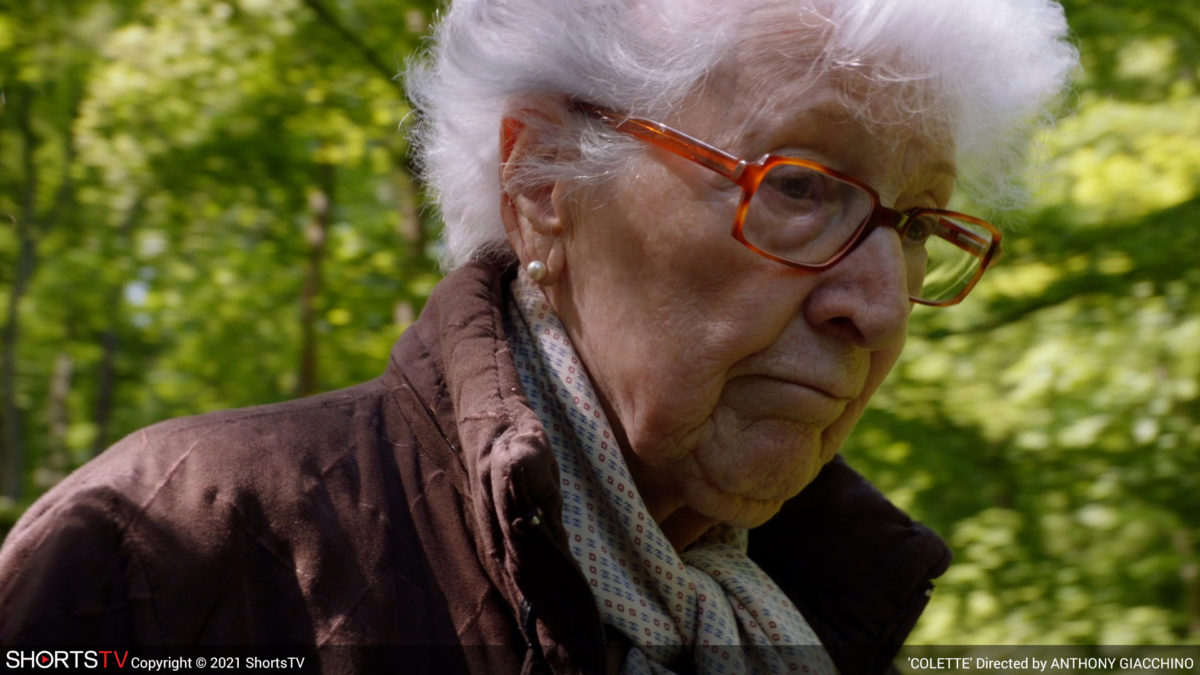
It’s been over seventy years since Colette Marin-Catherine’s brother Jean-Pierre was arrested in France and deported to the German concentration camp where he would later die. You can’t blame her for never wanting to go to see the site considering the anguish she’s dealt with in the aftermath and knowing the ways in which such places of abject horror have become tourist attractions in the decades since. As a so-called “woman who doesn’t cry,” it was thus an impossibility to deal with the emotions such a trip would conjure amongst disconnected strangers. Only when a student writing a paper on Jean-Pierre comes calling does Colette reconsider the journey. Together they will walk where he walked and remember the sacrifice he made regardless of their inevitable tears.
Director Anthony Giacchino’s Colette documents the event with the care and grace that it deserves. Whether we’re inside Colette’s apartment the day Lucie Fouble meets her, in a German tavern to hear the city’s former mayor speak about his nation’s undying guilt, or following behind as these two women visit the tunnels and crematorium that served as Jean-Pierre’s final residence, everything seen and heard is from their perspective—uncensored and devoid of manipulation. That which occurs unfolds straight from the heart as Colette speaks about the loss her genius brother was when compared to her own youthful ignorance being relegated to writing down vehicle numbers for the French resistance or repays Lucie with a gift that can never be quantified. It’s a catharsis that carries a heavy price.
Beyond Colette’s experience reliving the past and seeing its setting first-hand, however, also comes an education in what went on. She’s a former resistance fighter after all—a hero considering only one percent of the population took up that mantle whether or not she accepts the term due to her age and duties at the time. And her companion is a historian who’s done the research to know exactly what her brother went through so that they can stand where he stood and absorb the weight of his truth. Watching them fall victim to that sorrow is enough to feel it ourselves to add our own tears with theirs. That they are able to put a face to this place’s suffering ensures that new generations will never forget.
A-
A Concerto Is a Conversation | USA | 13 MINS
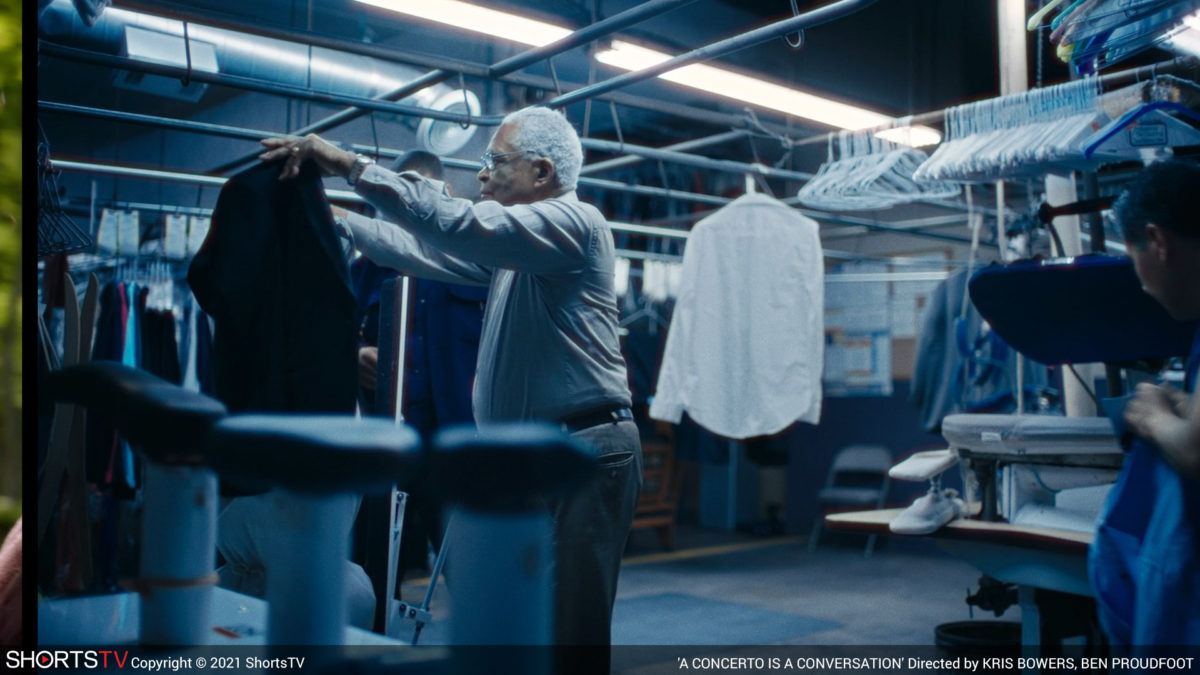
As composer Kris Bowers elaborates upon the title of his and Ben Proudfoot’s short documentary A Concerto Is a Conversation, we the viewers begin to understand he’s talking about this film as much as he is the piece that’s about to debut at the Walt Disney Concert Hall in Los Angeles. He’s explaining to his grandfather Horace Bowers Sr. that a concerto is a work pitting a soloist against an ensemble. They speak to each other through the music either with alternating passages or in concert much like people do when sharing a conversation. So while the exchange happening on-screen may seem like it’s one that’s just between these two men, the dialogue soon reaches back into the past to expose the orchestra sitting beside them.
Because what is this dynamic if not a discussion between past and present with Horace proving a conduit reaching back towards the heritage Kris was born from? The younger Bowers is therefore the soloist, the elder Bowers a mouthpiece for the sprawling group of “musicians” that laid the foundation for his success. So we hear about what it was like growing up in the south during the 1930s. We learn about Horace’s decision to hitchhike across America and subsequently end up in California with a rather ingenious way of securing work. And we listen to him recount his struggle against prejudice to make something of himself by securing a seat at the table he earned from those who refused to believe the color of his skin was worthy.
The visuals cut between an interview individually framing Horace and Kris in high definition as they ask and answer questions and archival images from the past depicting Jim Crow in a broad sense and photographic evidence of the Bowers family having lived through it. And Kris’ music plays the whole time—another project to accompany his Emmy-nominated work on “When They See Us” and his score for Green Book (a quick glimpse at the Oscar ceremony with Peter Farrelly on-stage is a weird segue if you weren’t already aware of this context going in). The film is intimate and enlightening in equal measure with impossible stories and the fruits of their authenticity. Despite being separated by generations, these Bowers men show the inseparability of their fates.
B+
Do Not Split | USA/Norway | 20 MINS
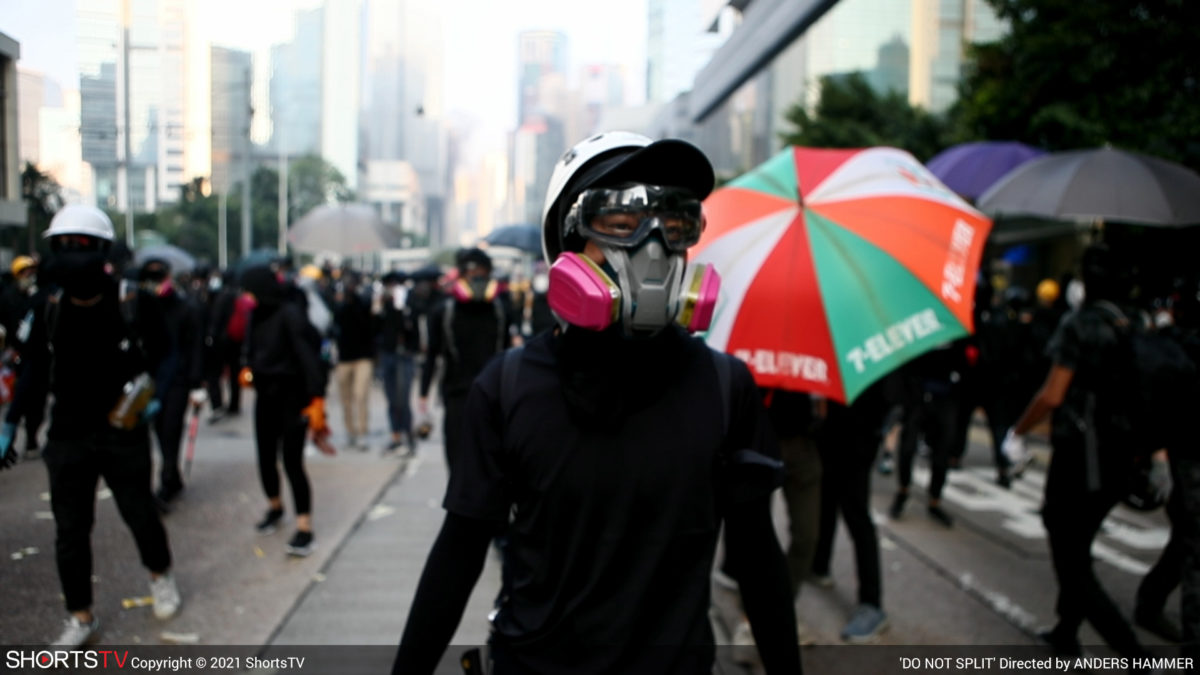
It’s hardly a new concept. If you start to blame people for something they aren’t doing, there’s a good chance they’ll start doing it. This is true for teenagers accused of trouble during school wondering what the point of being good is if they’ll just be blamed for being bad anyway and it’s true for peaceful protestors constantly getting confronted by armed police treating them like they are violent rioters by default. What choice do they therefore have besides becoming exactly that to survive? If they’re being tear-gassed and arrested for merely standing in the street, why not make their mark and see whether doing what they’re accused of doing might finally give the police pause? If they’re going to get beaten anyway, why not throw a punch?
That’s the question protestors everywhere ask themselves and what this current wave of disruptors in Hong Kong have excelled at answering. Director Anders Hammer’s Do Not Split proves a great document of that truth by filming multiple demonstrations that occurred in 2019 as China threatened to pass new laws that allowed them to extradite anyone they wanted to the mainland—a process that has been handing down guilty sentence at a 99% clip. So rather than watch as their home becomes a police state, these Hong Kong residents have taken to the streets to fight back. They didn’t start this war, but they surely aren’t going to be the ones to concede it out of fear. So they organize, demonstrate, and stream for the world to bear witness.
Anyone who’s been on social media the past year in America knows all too well what’s been happening in Hong Kong and many have been using those experiences to help them protest injustices here during Black Lives Matter protests. The ways in which tear gas has been dispersed and cannisters trapped under cones are being studied and implemented so future groups of oppressed people struggling for their democracy can follow suit and maybe even win. So even though we watch as China passes new laws cracking down and creating a humanitarian crisis, we can still hold onto hope that change is coming. Hammer’s film becomes a ground level battle cry as a result that captures the strength and courage of protestors opposite the cowardice of police.
The story it tells is thus less about narrative than newsreel content. Does that make it less compelling? No. But it doesn’t necessarily help it standout above its peers beyond its access level. Hammer and Point of Vision are ensuring that these crucial voices are heard and the uncensored evidence of brutality against them is shown and for that it’s undeniably an important documentary that deserves as wide an audience as possible. Any fatigue I may harbor is thus about the sheer number of these accounts rather than the content itself. It says something about the state of our world that this sort of military-based totalitarian rule has become the norm. So despite it feeling as though we’ve seen it all before, we must never stop watching.
B
Hunger Ward | USA | 40 MINS
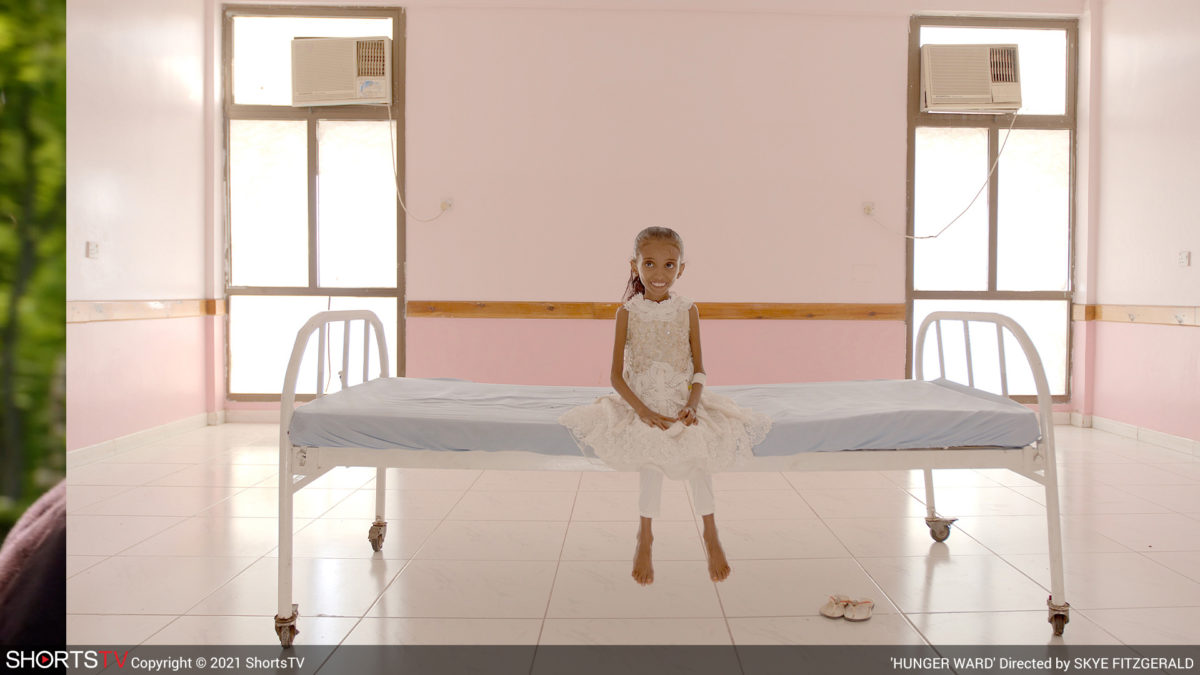
It shouldn’t be surprising that Skye Fitzgerald’s documentary short Hunger Ward proves a tough watch considering many in America and Europe are unaware of the tragedy unfolding in Yemen despite its 2014 origins. We’re talking about the worst famine in one hundred years ignited by a civil war that those knowledgeable of the conflict say is really an offshoot of a bigger one between Saudi Arabia (who supports the former government) and Iran (who supports the rebel government that has taken power). And as the fight spills over into the community due to bombings (of which the US is complicit) and blockades, the death toll mounts. Pair a crumbling infrastructure with dwindling resources and you receive a population unable to sustain itself long enough to find a solution.
That I myself learned the details of this situation post-viewing, however, reveals how the film itself is less about educating us on the humanitarian crisis’ genesis than it is ensuring we cannot look away. And you can’t blame Fitzgerald for going in that direction—even if you believe the now twice Oscar-nominated director’s work is little more than polished advertisements for donations. Why? Because it’s been seven years. Audiences have had seven years to take note of what’s happening. We in America finally saw our government take action in 2019 to cease our participation (selling weapons) only to watch Donald Trump veto the resolution and the Senate fail to come up with the votes to override him (we’ve steadily become a country that values blood money over lives).
So rather than give us a lecture about information we can easily look up ourselves, Fitzgerald throws us into the collateral damage. We glean bits and pieces from what Dr. Aida Alsadeeq and Nurse Mekkia Mahdi say in context with the child patients they’re desperate to save from starvation and the footage that a gentleman captured during the aftermath of a bombing at a funeral he was attending—enough to understand their stakes and the ambivalence of outside forces willing to use Yemen as a battleground to wreak havoc without suffering the cost. We can infer the sacrifices being made and the soldiers torn apart. What we too often forget are the civilian lives affected right along with them. These children are dying without any means of recourse.
Know then that along with little Omeima and Abeer as cute faces on the mend come other nameless children taking their last breathes on-screen via a breathing pump. Know that along with the smiling kids playing with balloons are the wails of mothers and grandmothers who are unable to cope with the reality of their situations. And it’s not just the visible hardships like a lack of food or water either. Add an increase in wheat allergies (the staple ingredient from aid packages) and families quite literally have no way to feed themselves due to the expense of every alternative. Hunger Ward is thus a harrowing glimpse into the heartache and futility experienced when war expands beyond the battlefield to target defenseless innocents inside their homes.
B
A Love Song for Latasha | USA | 19 MINS
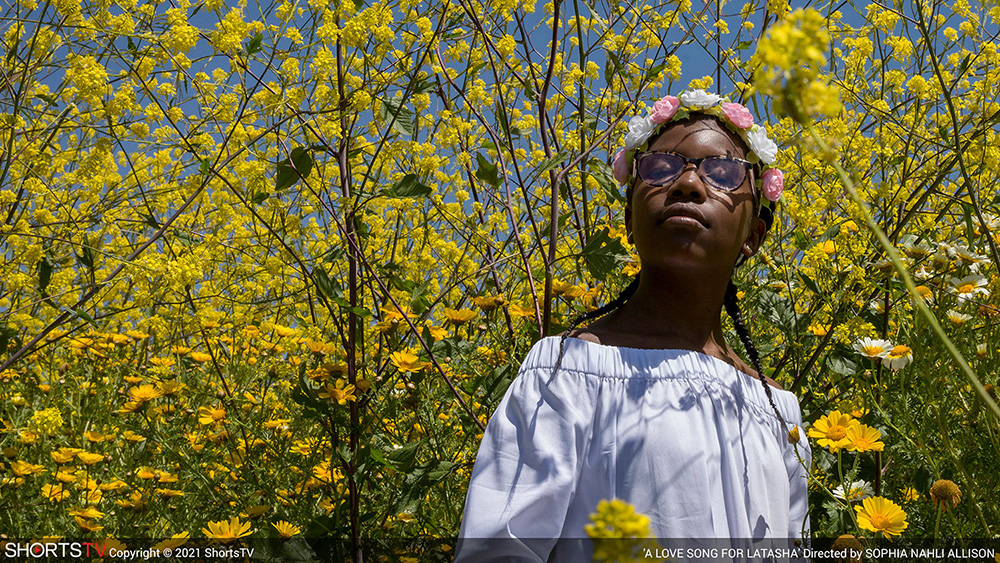
When the subject of your documentary is the tragic death of a fifteen-year-old Black girl accused of stealing an orange juice while holding the two dollars she was about to use for the purchase, the decision to embrace poetic abstract over reenactment is an easy one to make. And that’s exactly what Sophia Nahli Allison does with her short A Love Song for Latasha. It might begin with the blue screen of a VCR complete with tracking lines as footage appears, but that footage isn’t actually of Latasha Harlins or her friends and family. Most of what we’re shown is instead populated by kids from today interacting like how she, her cousin Shinese, and her best friend Ty would back in the late-1980s. Allison is setting the stage.
She’s presenting the joy and promise children hold in South Central Los Angeles despite the dangers lurking as a result of the color of your skin. She’s highlighting the easy-going nature of best friends eating together or swimming like Tasha, Shinese, and Ty possessed three decades ago. That it plays against the words the latter two recount via memories imbues each sequence with a duality of meaning that inevitably reminds us how little has changed—both in that desire to live life with a smile and the uncertainty in knowing whether or not you’ll be able to do so tomorrow. Because knowing gun violence and racism exists regardless isn’t enough upon learning this particular death came at the hands of someone these kids knew to fear.
Latasha’s murder was a major spark for the 1992 LA riots and an indelible moment for young Black children everywhere, but to push in and showcase its impact on the two people closest to her only amplifies its power further. When the topic of that specific day arises, Allison shifts from pictorial representation to color fields and paint flickering over and over again as we envision the event ourselves through the narrators’ words. To hear these women speak about not knowing what terror was until then epitomizes the loss of innocence that no one this young should have to understand. And yet our country continues to ensure that young Black boys and girls do in order to survive. We force these kids to know their skin conjures hate.
For what? Two dollars? Are we so afraid that pulling a gun on a teenager because we presume trouble is enough to devalue a human life into pocket change? Or are we emboldened by the fact that those in power think that way too when the victim being dehumanized is a color society has been conditioned to fear? There are no excuses—especially not this time around when you hear Shinese and Ty talk about Tasha being a straight-A student with aspirations to attend law school. The repeat offender in this case was the person pulling the trigger and yet they walked free. Rather than treat Tasha as the statistic she strove to never become, remember these words and the beauty of what should have been.
B+
Live-Action
Feeling Through | USA | 19 MINS
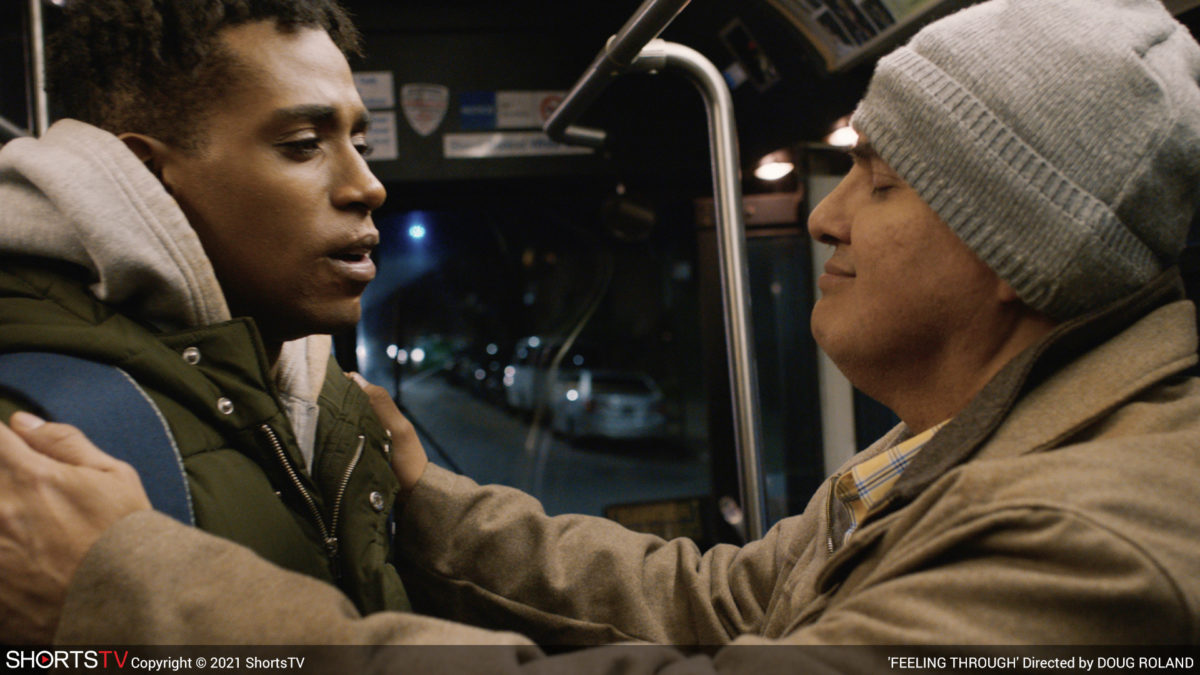
If writer/director Doug Roland isn’t careful, his short film Feeling Through might find itself diminishing the plight of the homeless simply by comparing someone living that experience with someone who is “worse off.” That’s the inherent danger of sentences like “Someone always has it worse.” While meant to be emboldening, these sentiments sometimes forget how your suffering is also real. So rather than focus on the differences separating a man who’s desperate to find a couch to crash on for the night like Tereek (Steven Prescod) and a middle-aged deaf and blind man like Artie (Robert Tarango), Roland mines through their respective struggles to unearth the similarity that binds them. Because if there’s one thing every human should know, asking for help doesn’t imply weakness. It reveals strength.
And despite Artie being stranded by the side of the road unless someone is willing to see him, read his sign, and give him their time to escort him where he needs to go, Tereek is the one who finds himself in direr straits. Why? Because he could have found a bed for the night if he asked. If he allowed himself to be vulnerable enough to tell the people he texts “why” rather than casually making it seem like he has other options, their “Nos” might have become “Yeses.” But he doesn’t. He pretends everything is fine and sits away from the friends who bought him food so he can scarf it down without the embarrassment that comes with admitting he hasn’t eaten all day.
On the flip side is Artie—a man with a smile on his face and unyielding trust in his heart. His survival is reliant upon the help of strangers and he believes they’ll provide it. Where Tereek hides his truth from those closest to him, Artie lets the world know his. So when the young man taps him on the shoulder to let him know he’ll guide him to the bus stop, Artie simply reacts as though nothing is amiss. That we don’t know how long he’s waited for that tap is the point. Whether five minutes or five hours, Artie patiently stood there with confidence that someone would come. If that’s not strength, I don’t know what is. And there’s no way Tereek doesn’t see it too.
The result is a powerfully dramatic release of his indoctrinated self-sufficiency. Tereek has been traveling through this night (and presumably much longer) with the notion that his inability to dig out of the hole he finds himself in renders him a failure. That’s how he looks at panhandlers begging for change. He tells himself that “self-respect” is keeping him from becoming another bum on the street when the truth is far more complex. To therefore put his ego aside and live for this other soul—even for just an hour—may ultimately become the most profound moment of his life. To see Artie’s courage is to recognize his own fear. Charity isn’t a crutch. It’s a necessity we all inevitably must accept since no one truly succeeds alone.
A-
The Letter Room | USA | 33 MINS
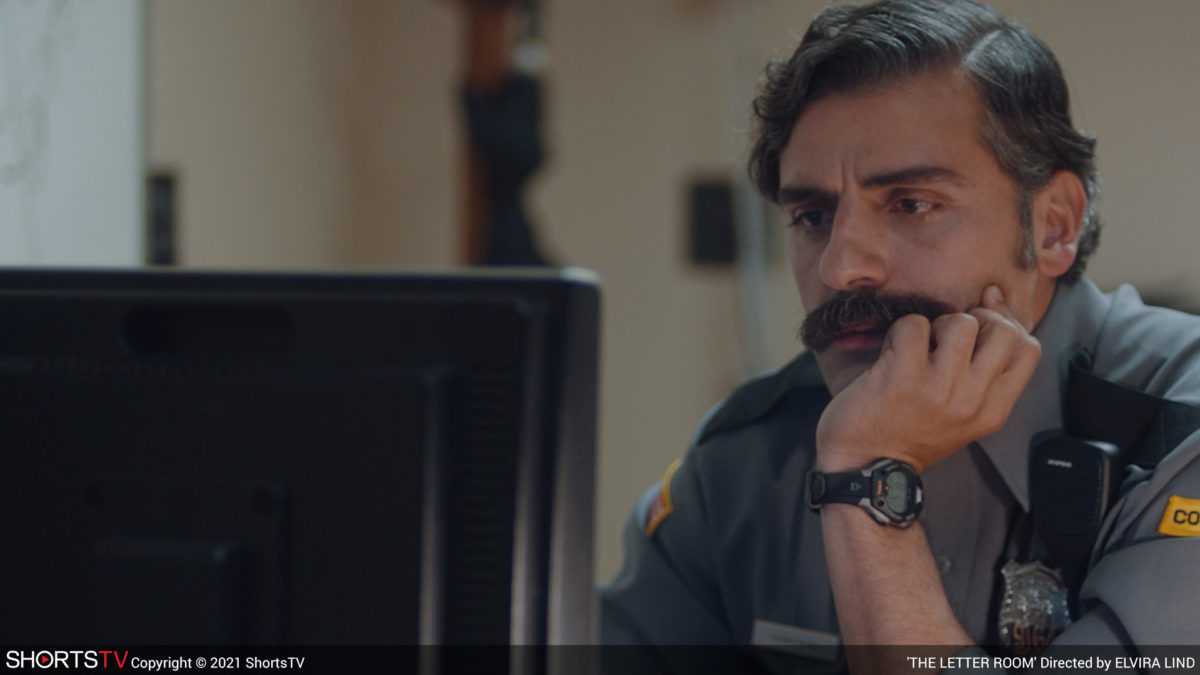
The fact that we’re being asked to sympathize with a man working as a corrections officer on death row isn’t lost on writer/director Elvira Lind. If anything, she wants us to make certain we acknowledge the moral disparity that exists so that we realize Richard (Oscar Isaac) is an exception and perhaps an answer to so much of what’s wrong with our current prison system. What he learns in The Letter Room is what too many in his position refuse to believe: that inmates are complex human beings dealing with an impossible situation no one truly knows how to process. Does that mean we should forget what these criminals have done? No. But it also doesn’t mean that a death sentence shuts the door on rehabilitation or compassion.
Richard can converse with Jackson (John Douglas Thompson) about a new book suggestion while his coworker gruffly belittles their dialogue so he can steal away attention to sexualize a woman he met the night before. Richard wants to engage on a level beyond the superficial—beyond the hyper-masculinity of the men wearing jumpsuits and those wearing uniforms. He even wants to transfer into a department that will let him converse with prisoners further by testing the boundaries of their psychology to get beneath the aggression that got them here in order to transcend higher. And when the warden (Eileen Galindo) tells him his wish was finally granted, he can’t help but beam until discovering the way it’s come true isn’t quite what he had in mind.
Rather than more one-on-one time with inmates, Richard is tasked with reading their mail so nothing untoward finds its way into their cells. What initially feels like a menial job, however, soon takes on a life of its own after absorbing the correspondence between a cop killer (Brian Petsos’ Cris) and his girlfriend (Alia Shawkat’s Rosita)—a one-sided conversation that Cris doesn’t even read let alone send a reply. While that should be the end of it, the fact Richard is reading means the things she says are no longer trapped on the page. They’re in his head now and some of her words aren’t so easily forgotten. Can he turn a blind eye if it means Cris might not be the only person who ends up dead?
Boundaries are crossed and preconceptions are tested as a result simply because Richard refuses to treat the men in his care as animals who deserve to be punished en route to their final punishment in the electric chair. By giving them the benefit of the doubt, he learns the power words hold for both the reader and the writer. Cris ignoring what Rosita writes doesn’t therefore negate the emotional impact those letters have on her as far as assuaging guilt or providing comfort—even if only in the abstract. And if writing is enough for her, maybe receiving them is enough for Cris. It’s a profoundly moving realization that may get undercut a bit by the humorous slant of the whole, but not enough to derail its impact.
B-
The Present | Palestine | 25 MINS
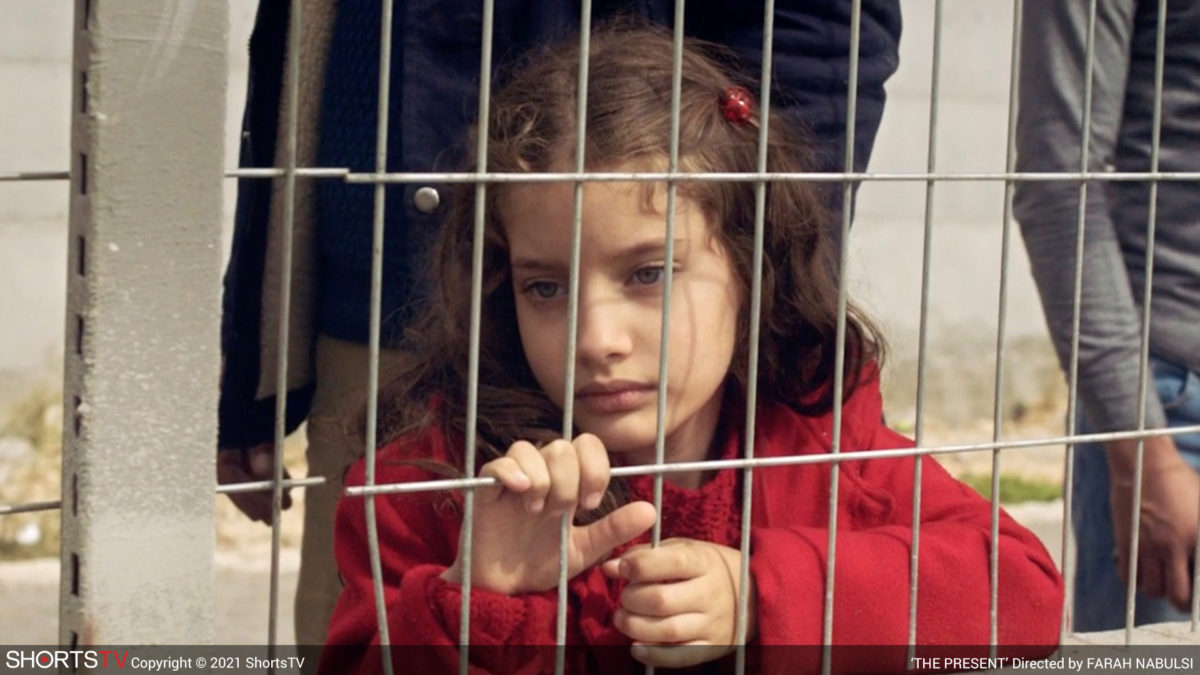
It’s easy for oppressive regimes to call their opposition terrorists when they have all the control. Wherever you may reside (look at the difference in rhetoric between how the American GOP described BLM protestors during the summer and white insurrectionists during the winter), power always breeds injustice. And it isn’t simply through action either. Some of the worst cases of exploitation and discrimination occur through inaction thanks to rules and regulations that allow humanity to be removed from the equation altogether. That’s why their control remains steadfast despite newer generations seeing through the indoctrination. Where choice could allow a rookie to let compassion dictate his/her response to blatantly innocuous situations, “procedure” beats individuality into submission until empathy is all but a fantasy relegated to fairy tales.
That’s what we’ve seen happen in Palestine for decades as Israel forcefully pushed its way into the West Bank. They take what isn’t theirs, bolster their position with armed soldiers, and hold the area’s residents hostage with rules that thinly veil their declaration of racial, cultural, and religious superiority. And they play the victim to the world when something goes wrong. They justify shooting innocent civilians because a rock or can was thrown in frustration all while reveling in their ability to ignite that provocation. To therefore watch the beginning of Farah Nabulsi’s The Present (co-written by Hind Shoufani) is to experience the sense of futility that has become intrinsic to Palestinian existence. Survival means playing a game that’s rigged to ensure you’re too tired to fight back.
What better way to appeal to foreigners deluded by Israel’s propaganda than an act as universal as shopping? It’s Yusef (Saleh Bakri) and Noor’s (Mariam Basha) anniversary and thus a day for relaxation and celebration. Where we could prepare days in advance and move independently around our town once hiccups arise, this family must deal with the fact that hiccups are permanent parts of the journey. Both the shop where Yusef bought Noor’s gift and the grocery store he must visit to collect dinner ingredients are beyond the checkpoint set-up a couple blocks from their house. So he and their young daughter Yasmine (Mariam Kanj) must walk, stand in line, risk lengthy security checks, and wonder whether or not they’ll even be let back through upon their return.
While the film’s runtime is only twenty minutes, our experience of the shift from day to night carries exasperated rage. Don’t you dare say the “if he complied with officers” line either since the people who use those words have never had to worry about their compliance still not being enough. This is psychological torture exacerbated by the callous indifference of a ruling class raised to treat their neighbors like animals. It’s a gross use of authority with a baked-in disregard for the impact their actions have on those they toy with out of sheer boredom. That Nabulsi is able to convey that message without bloodshed is almost a miracle and yet there’s nothing happy about her conclusion. Not when Yusef must endure it all again tomorrow.
B
Two Distant Strangers | USA | 29 MINS
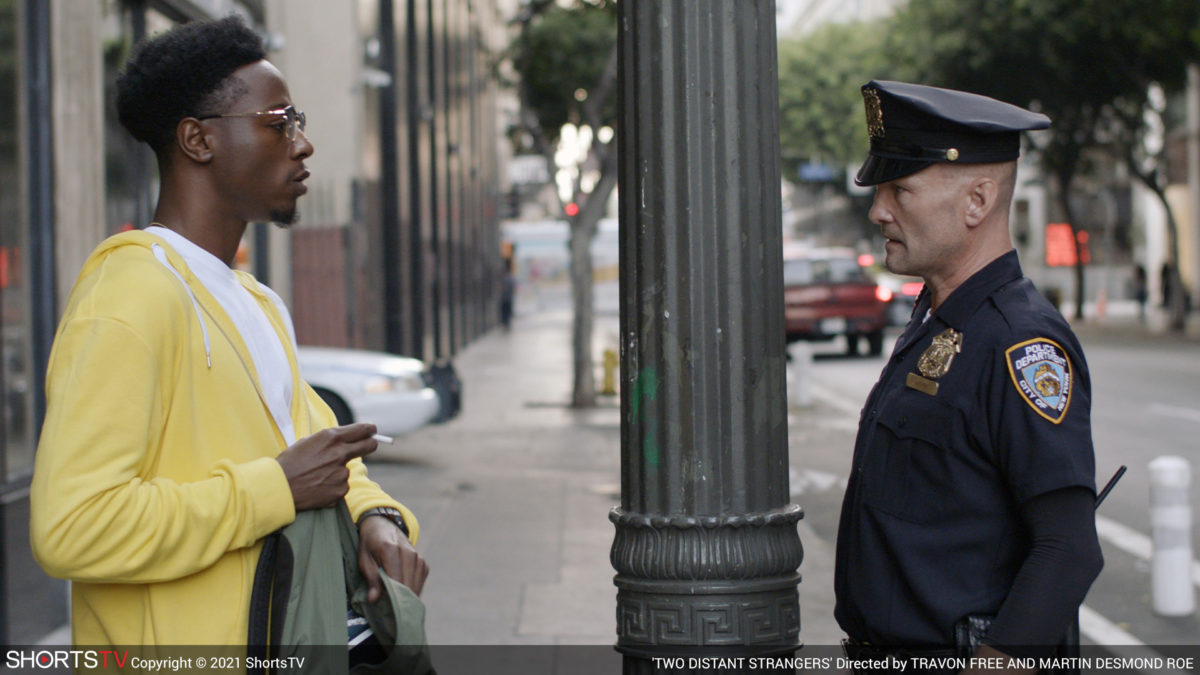
You can’t read the synopsis for Travon Free and Martin Desmond Roe’s short film Two Distant Strangers and not think about The Obituary of Tunde Johnson—if you’ve seen it. Both utilize a time-loop scenario wherein their lead Black character is stuck in a never-ending cycle of police brutality always ending up with him shot dead. The difference between the two ends up being the fact that Free and Roe have less time to work with and thus less room to let their conceit breathe. So rather than give Carter (Joey Bada$$) the ability to discover, explore, and alter his forward progress like the aforementioned feature, he’s firmly cemented as one half of an unavoidable whole. No matter what he does, it remains him versus Officer Merk (Andrew Howard).
This isn’t necessarily a bad thing, though, as its more specific focus ultimately distills a situation that’s all too prevalent in America to its most potent form. Whether or not Carter leaves his date’s apartment with a yellow hoodie, a t-shirt, a backpack, a cigarette, or whatever else he has on his person at that moment, Merk will always be there to accuse him of walking while Black. Whether Carter knocks into someone and spills their coffee, opens a door for a businessman, or tries to run, Merk will either put him in a chokehold while declaring an unwillingness for compliance or simply pull out his gun and shoot him in cold blood. It happens over and over again until Perri (Zaria) makes a suggestion. Talk to him.
It’s here that I started checking out because watching this character hear that advice and have it become his newfound driving force for change rang wrong to me. Why should Carter, the victim, be the one that needs to talk? Why should he (the Black man) have to shoulder the responsibility of Merk’s (the white man) racism? Suddenly what had been a depiction of the Black experience seemed to be skewing into “a white person’s version of the Black experience.” Thankfully something happens to throw another wrench that let the movie deliver because its ability to make us question whether it should be on the Carters of this world to “fix” what’s wrong is important. The shifts between comedy and drama, absurd circumstances and hard truths is too.
The execution of those juxtapositions felt off as a result because I couldn’t shake the incongruity of championing Carter’s inspiring motivation to persevere by forcing the responsibility for change on him and not those refusing to listen. Rather than demand transformation from white America, this presupposes that compromise is possible as though mutual fault exists. It doesn’t. The ending, however, reveals potential confusion in that I’m not Black and perhaps missed the nuance to realize what I read as optimism was actually futility. Maybe having Carter be willing to do anything is the point because it exposes how the shouldering of white America’s responsibility still can’t save him. Saying he’ll make it home isn’t therefore positive thinking. It’s simply what Black America says to get out of bed.
B
White Eye | Israel | 21 MINS
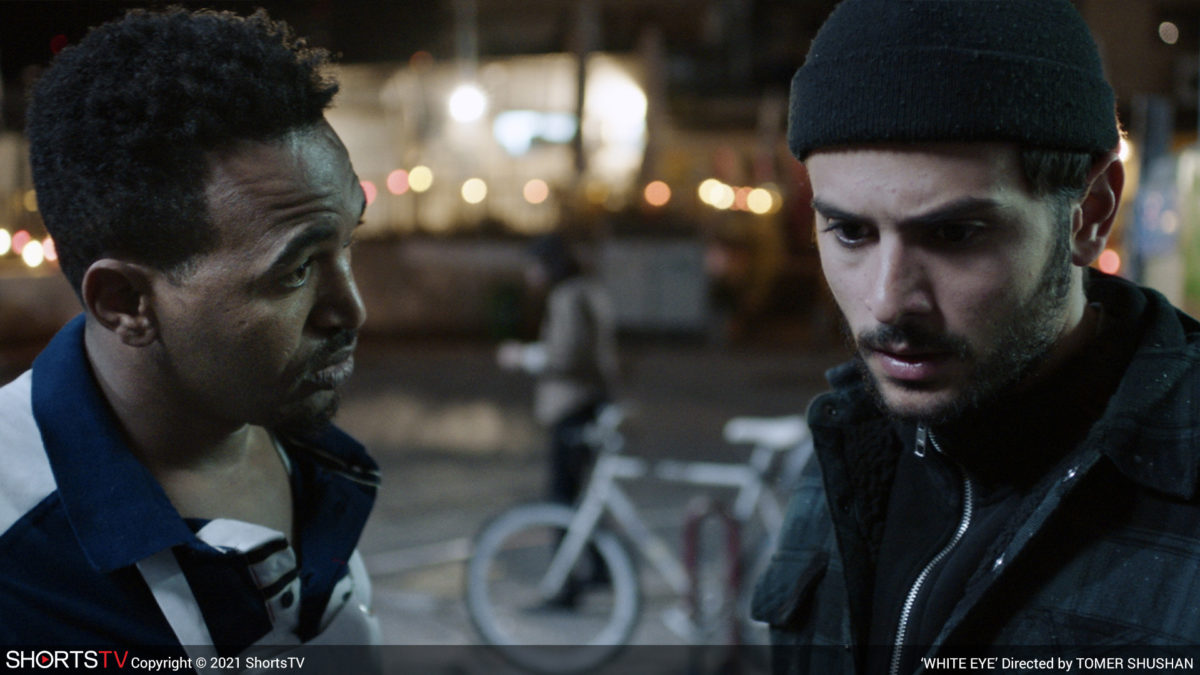
It’s one thing to create a morality play that teaches its lesson while leaving everyone better people by the end, but it’s another to create one that actually maintains authenticity. Because let’s face it: lessons often come at a price. And when said lesson involves the police, that price can be a lot steeper than you may have assumed. We therefore know things will most likely devolve the moment Omer (Daniel Gad) calls them to deal with his situation on the record because their involvement will inevitably open doors to issues that have nothing to do with why he picked up the phone. And by the time he finally realizes this truth and comprehends his complicity, it will most likely already be too late to set things right.
Tomer Shushan’s White Eye unfolds as a single continuous take focused on Omer as he discovers the bike that was stolen from him on the beach a month ago is now inexplicably chained across the street. After recognizing a dent from an accident and a sticker from his girlfriend, he immediately phones the authorities to receive permission to break the lock. Without proof of purchase or a compliant on file, however, they can’t provide that endorsement. The best they can do is drive over the minute he calls back saying the thief has returned. That seems enough on the surface (unless he can cajole a bystander to help “steal” it back by breaking the lock), but it also carries obvious consequences. Maybe the new owner wasn’t the thief?
And when Yunes (Dawit Tekelaeb) says he bought it one week prior, the math makes sense that he wasn’t. When the Eritrean immigrant’s boss (Reut Akkerman) vouches for his character and honesty, we realize this whole scenario got a lot more complicated. Add a Tel Aviv setting, Omer being Israeli, and one of the officers being devoutly religious and you can begin to anticipate just how badly things might get. Go further and add a very specific price point of 250 shekels expertly mirrored so that Shushan can expose the bigoted tendencies of our indignation and you literally watch as Omer’s fierce sanctimony fades in the matter of seconds. Because while he didn’t set out to destroy a life this night, righteous anger rarely requires the brain’s consent.
B+
ShortsTV presents the Oscar® Nominated Short Films globally in theatrical and virtual cinemas starting on April 2, 2021. To learn more about the participating theaters (in-person and virtually) and how to purchase tickets, please visit here.
